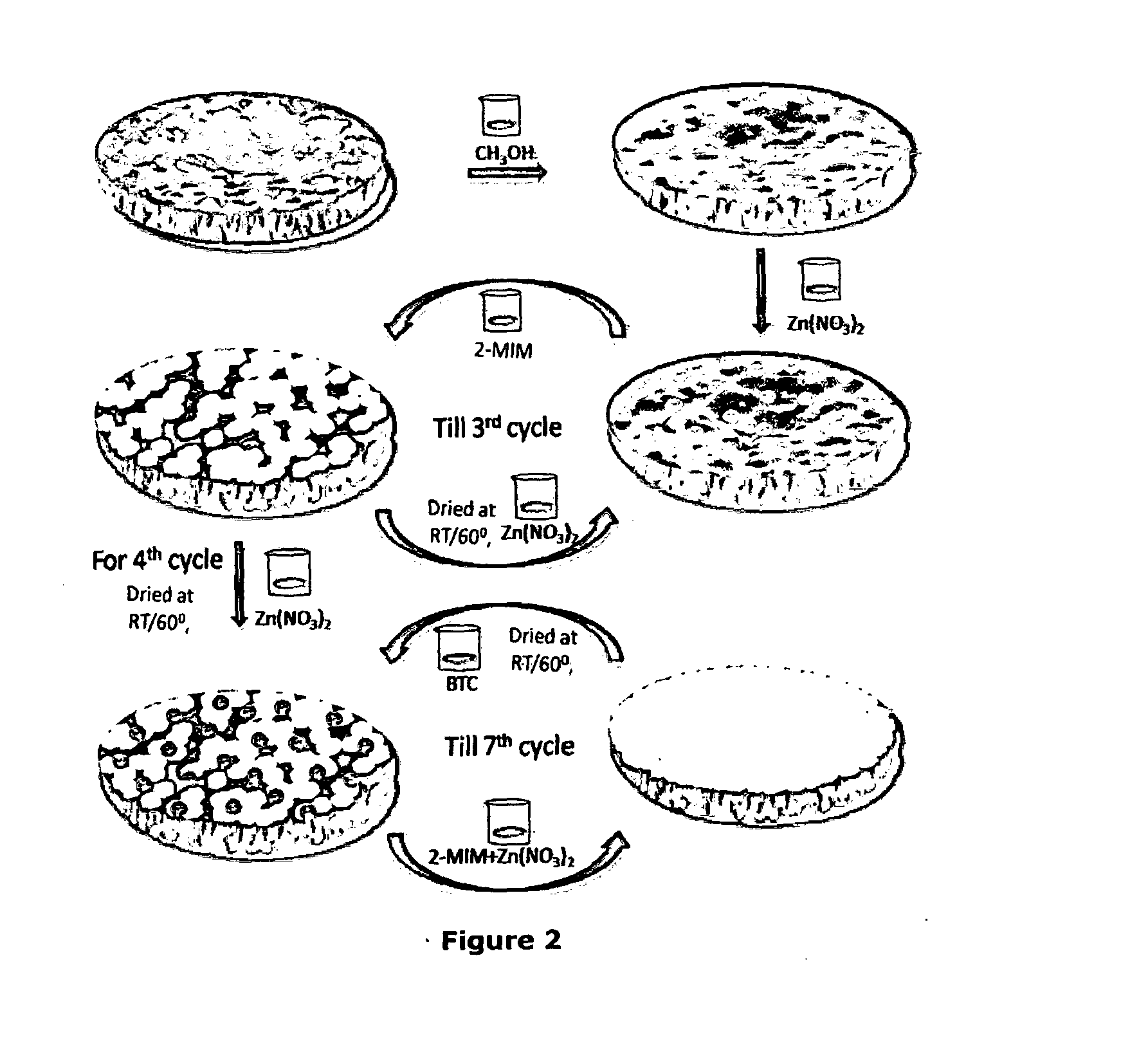Process for the preparation of mofs-porous polymeric membrane composites
a polymeric membrane and composite technology, applied in membrane technology, membrane separation processes, membranes, etc., can solve the problems of affecting the production of continuous sheets for practical applications, affecting the use of continuous sheets, sedimentation and agglomeration of crystals
- Summary
- Abstract
- Description
- Claims
- Application Information
AI Technical Summary
Benefits of technology
Problems solved by technology
Method used
Image
Examples
example 1
Casting of PAN-17 Membranes
[0086]Flat sheet PAN-based ultrafiltration membrane was prepared by phase inversion method. A doped solution containing 136 g of dried PAN powder and 26.56 of ZnCl2 in 637.44 g of N-methyl pyrrolidone (NMP) was prepared by stirring for 48 h at dry conditions. The formed doped solution was degassed and then centrifuged at ˜2700 rpm for 3 h. The membrane was casted on moving non-woven support fabric using pilot scale continuous membrane casting facility at 17° C. gelation temperature and 41° C. curing temperature. The formed membrane had an average thickness of ˜250 μm and was stored with aqueous formalin solution (0.5%) at 4° C. until further use. The gas permeation study was done on these membranes and the results are as follows:
TABLE 1Gas permeation study of PAN-17PermeationSelectivityC3H6CO2CH4H2H2 / C3H6CO2 / C3H6CH4 / C3H6PAN-1778776912252995412
example 2
Hydrolysis of PAN-17 for 2 Hrs
[0087]Membrane sample was mounted in a cross-flow cell and 1N NaOH solution was circulated with trans-membrane pressure of 100 kPa for 2 h at 40° C. The NaOH treatment was followed by post-HCl treatment by circulating 0.5 N HCl solution at 1 bar, till 150 mL of permeate (HCl solution) was collected. Such hydrolyzed membranes were cut into circular coupons and dried at RT and further used for gas permeation study.
example 3
Synthesis of CuBTC@Hy-PAN (2 Hrs) Composite Membranes
[0088]Hydrolysed PAN membrane was washed with water to remove formalin and cut into circular coupons / sections of 5 cm in diameter. During the first cycle, about ten membranes separated by a polypropylene mesh spacer were first dipped in 250 ml beaker containing 200 ml mixture of DMF:EtOH:H2O (1:1:1 volume ratio) for 6 hrs and then into a 250 ml beaker containing BTC (10 g, 2.38 mmol) and TEA (triethyl amine) (10.0 ml) in 240 ml of 1:1:1 volume ratio of above solvent mixture for 12 hrs. The BTC loaded membranes were immersed into Cu(NO3)2 solution (16 g, 4.31 mmol) in 240 ml of 1:1:1 mixture of DMF:EtOH:H2O for 12 hrs and the membranes were washed with water followed by drying the membranes at room temperature conditions ranging from 20-40° C. The same procedure was followed till 4th cycle. The gas permeation study was done on those membranes after 4th cycle and the result is as given in Table 2.
TABLE 2Gas permeation study of CuBTC...
PUM
| Property | Measurement | Unit |
|---|---|---|
| temperature | aaaaa | aaaaa |
| size | aaaaa | aaaaa |
| size | aaaaa | aaaaa |
Abstract
Description
Claims
Application Information
 Login to View More
Login to View More - R&D
- Intellectual Property
- Life Sciences
- Materials
- Tech Scout
- Unparalleled Data Quality
- Higher Quality Content
- 60% Fewer Hallucinations
Browse by: Latest US Patents, China's latest patents, Technical Efficacy Thesaurus, Application Domain, Technology Topic, Popular Technical Reports.
© 2025 PatSnap. All rights reserved.Legal|Privacy policy|Modern Slavery Act Transparency Statement|Sitemap|About US| Contact US: help@patsnap.com



